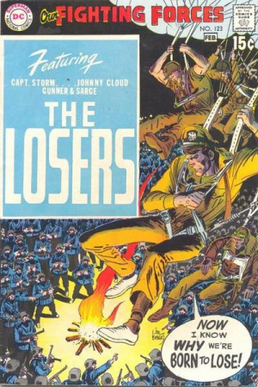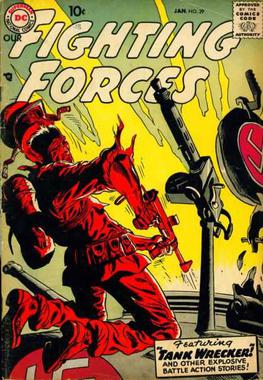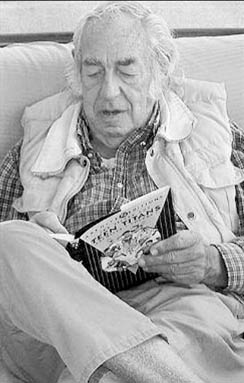Related Research Articles

Mars Attacks is a science fiction-themed trading card series released in 1962 by Topps. The cards feature artwork by science fiction artists Wally Wood and Norman Saunders. The cards form a story arc, which tells of the invasion of Earth by cruel, hideous Martians under the command of a corrupt Martian government who conceal the fact from the Martian populace that Mars is doomed to explode and, therefore, proposes colonization of Earth to turn it into their new homeworld. The cards depict futuristic battle scenes and bizarre methods of Martian attack, torture and slaughter of humans, as well as various Earth nations being attacked. The story concludes with an expeditionary force of humans volunteering to embark on a counterattack on Mars, in which the Earth force attacks the Martians in their manner. This necessitates the Martians that are still on Mars to defend their homeworld. The Earth attack forces, after destroying the Martian cities and killing the Martians, depart just before Mars is destroyed in the predicted cataclysm, thus ensuring the peace and safety of Earth as the Martian race is seemingly doomed to extinction.

Sgt. Fury and his Howling Commandos is a comic book series created by Jack Kirby and Stan Lee and published by Marvel Comics from 1963 to 1981. The main character, Sgt. Nick Fury, later became the leader of Marvel's super-spy agency, S.H.I.E.L.D. The title also featured the Howling Commandos, a fictional World War II unit that first appeared in Sgt. Fury and his Howling Commandos #1.

Sgt. Franklin John Rock is a fictional character appearing in American comic books published by DC Comics. Sgt. Rock first appeared in Our Army at War #83, and was created by Robert Kanigher and Joe Kubert. The character is a World War II soldier who served as an infantry non-commissioned officer.
Captain Action was an action figure created in 1966, equipped with a wardrobe of costumes and facial masks allowing him to become Superman, Batman, Spider-Man, Captain America, Aquaman, the Phantom, The Lone Ranger, Flash Gordon, Buck Rogers, Sgt. Fury, Steve Canyon, and the Green Hornet. Captain Action was the Ideal Toy Company's answer to Hasbro's G.I. Joe, although the protagonist dolls of both toy lines were created and designed by the same toy-and-idea man, Stan Weston. Captain Action also had a working 4 foot parachute.

The Losers is the name of a war comic book feature published by DC Comics. The name was later given to a reimagined comic book series for DC's Vertigo imprint.

Sally Forth was an American comic strip created by Wally Wood for a military male readership, featuring a sexy action-adventure character who is often depicted nude. Her name is a play on words – "to sally forth" means to leave or attack from a military encampment.
Robert Kanigher was an American comic book writer and editor whose career spanned five decades. He was involved with the Wonder Woman franchise for over twenty years, taking over the scripting from creator William Moulton Marston. In addition, Kanigher spent many years in charge of DC Comics's war titles and created the character Sgt. Rock. Kanigher scripted what is considered the first Silver Age comic book story, "Mystery of the Human Thunderbolt!", which introduced the Barry Allen version of the Flash in Showcase #4.

Vision (Aarkus) is a superhero appearing in American comic books published by Marvel Comics. Created by the writer Joe Simon and artist Jack Kirby, the character first appeared during the Golden Age of comic books in Marvel Mystery Comics #13, published by Marvel predecessor Timely Comics.

Franklin Robbins was an American comic book and comic strip artist and writer, as well as a prominent painter whose work appeared in museums including the Whitney Museum of American Art, where one of his paintings was featured in the 1955 Whitney Annual Exhibition of American Painting.
Phantom Eagle is the name used by two fictional aviator heroes appearing in American comic books.

Our Fighting Forces is a war comics anthology series published by DC Comics for 181 issues from 1954 to 1978.

The Haunted Tank is a comic book feature that appeared in the DC Comics anthology war title G.I. Combat from 1961 through 1987.
Samuel Joseph Glanzman was an American comics artist and memoirist. Glanzman is best known for his Charlton Comics series Hercules, about the mythological Greek demigod; his autobiographical war stories about his service aboard the U.S.S. Stevens for DC Comics and Marvel Comics; and the Charlton Comics Fightin' Army feature "The Lonely War of Willy Schultz", a Vietnam War-era serial about a German-American U.S. Army captain during World War II.

Shock Gibson is a fictional comic book superhero who first appeared in Speed Comics #1, from Brookwood Publications. He was created by artist Maurice Scott, who drew it through issue #11, and an unknown writer. His 1939 introduction makes him one of comic books' earliest superheroes. He also appeared in All-New Comics #8.
The Leatherneck Raiders are a fictional World War II unit appearing in American comic books published by Marvel Comics. Created by Gary Friedrich and Dick Ayers, they were a specially trained tactical commando squad. "Leatherneck" is a military slang term for a member of the United States Marine Corps, the Marine Raiders were a special World War II unit. The character Captain Savage is unrelated to the 1939 Fox Feature Syndicate character of that name.

The Face is a fictional character, a comic book superhero that appeared in 1940s comics during what historians and fans call the Golden Age of Comic Books. He was created by artist Mart Bailey and an unknown writer.

The 202nd Coastal Ranger Company is an amphibious special operations capable ranger unit within the Swedish Amphibious Corps, which is the maritime land force arm of the Swedish Navy.
Novelty Press was an American Golden Age comic-book publisher that operated from 1940 to 1949. It was the comic book imprint of Curtis Publishing Company, publisher of The Saturday Evening Post. Among Novelty's best-known and longest-running titles were the companion titles Blue Bolt and Target Comics.

Robert Gilbert Haney, Jr. was an American comic book writer, best known for his work for DC Comics. He co-created the Teen Titans as well as characters such as Lance Bruner, Metamorpho, Eclipso, Cain, and the Super-Sons.

Captain Savage and his Leatherneck Raiders is a World War II comic book published by Marvel Comics. The series lasted for nineteen issues, from January 1968 to March 1970. By issue #9 the name was switched to Captain Savage and his Battlefield Raiders. Created by Gary Friedrich and Dick Ayers, the book was a spin-off of the series Sgt. Fury and his Howling Commandos which they wrote at the time. The series was launched when Marvel suddenly received the ability to publish more titles than they had previously due to an embargo.
References
- ↑ Wells, John (2014). American Comic Book Chronicles: 1965-1969. TwoMorrows Publishing. p. 54. ISBN 978-1605490557.
- ↑ Markstein, Don. "M.A.R.S. Patrol Total War". Don Markstein's Toonopedia. Retrieved 2 April 2020.